新闻英语文献
写新闻的出处和新闻的内容和看到英语作文450
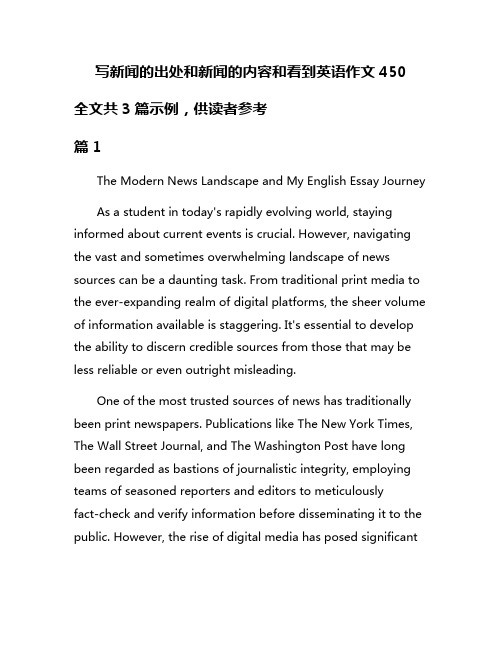
写新闻的出处和新闻的内容和看到英语作文450全文共3篇示例,供读者参考篇1The Modern News Landscape and My English Essay JourneyAs a student in today's rapidly evolving world, staying informed about current events is crucial. However, navigating the vast and sometimes overwhelming landscape of news sources can be a daunting task. From traditional print media to the ever-expanding realm of digital platforms, the sheer volume of information available is staggering. It's essential to develop the ability to discern credible sources from those that may be less reliable or even outright misleading.One of the most trusted sources of news has traditionally been print newspapers. Publications like The New York Times, The Wall Street Journal, and The Washington Post have long been regarded as bastions of journalistic integrity, employing teams of seasoned reporters and editors to meticulouslyfact-check and verify information before disseminating it to the public. However, the rise of digital media has posed significantchallenges to the print industry, forcing many newspapers to adapt or face obsolescence.Online news sources have gained tremendous traction in recent years, offering a level of immediacy and accessibility that print media simply cannot match. Websites like CNN, BBC, and Reuters have established themselves as reputable digital news providers, leveraging the power of the internet to deliver breaking news in real-time. Additionally, the emergence of social media platforms like Twitter and Facebook has dramatically transformed the way news is consumed and shared, allowing information to spread rapidly across global networks.However, the ease of content creation and dissemination on the internet has also given rise to an alarming proliferation of misinformation and "fake news." Unscrupulous individuals or organizations can easily create and distribute false or misleading information, often with the intent of advancing specific agendas or sowing discord. It is imperative for consumers of news to develop critical thinking skills and fact-checking habits to navigate this landscape responsibly.Amidst this complex news ecosystem, one of the challenges I faced as a student was mastering the art of English essay writing. The ability to articulate thoughts and ideas clearly and conciselyis a valuable skill, not only in academic settings but also in professional and personal contexts. My journey towards achieving a score of 450 on an English essay was a testament to perseverance, dedication, and a willingness to learn and adapt.Initially, the prospect of crafting a compelling essay in a language that was not my native tongue was daunting. I struggled with grammar, vocabulary, and the nuances of English expression. However, through consistent practice and a commitment to continuous improvement, I began to make progress.One of the key strategies that aided my development was immersing myself in high-quality English literature and media. By reading works from acclaimed authors and engaging with reputable news sources, I was able to absorb the cadence and idiomatic expressions of the language. This exposure not only expanded my vocabulary but also provided me with a deeper understanding of how to structure arguments and present ideas in a coherent and persuasive manner.Additionally, I sought out resources and guidance from experienced English instructors and writing tutors. Their feedback and insights were invaluable, helping me to identify areas for improvement and refine my writing techniques. Theyencouraged me to embrace the iterative process of drafting, revising, and editing, emphasizing that polished writing is rarely achieved in a single attempt.As my skills progressed, I began to approach essay writing with a more strategic mindset. I learned to carefully analyze prompts, identifying key points and themes that needed to be addressed. I developed an appreciation for the importance of supporting arguments with relevant evidence and examples, creating a logical flow that guided the reader through my thought process.Moreover, I discovered the value of adopting a unique and engaging writing style. While adhering to the conventions of formal academic writing, I sought to infuse my essays with a distinctive voice that resonated with readers. I experimented with rhetorical devices, vivid imagery, and strategic use of anecdotes or personal experiences to captivate and persuade my audience.The journey towards achieving a score of 450 on an English essay was not without its challenges. There were moments of frustration, self-doubt, and the temptation to settle for mediocrity. However, by cultivating a growth mindset andembracing the process of continuous learning, I was able to overcome these obstacles and ultimately achieve my goal.In retrospect, the skills and lessons I acquired through this experience extend far beyond the confines of a single essay or academic pursuit. The ability to critically analyze information, discern credible sources, and articulate ideas effectively are invaluable assets in navigating the complexities of the modern news landscape and life in general.As I look towards the future, I am committed to remaining an active and engaged consumer of news, constantly seeking out diverse perspectives and fact-checking information from multiple reliable sources. I am also dedicated to continuing to hone my writing abilities, recognizing that clear and effective communication is a powerful tool for inspiring change, shaping narratives, and making a positive impact on the world around me.In conclusion, the journey of navigating the news landscape and mastering English essay writing has been a transformative experience. It has equipped me with the tools to critically evaluate information, express myself with clarity and confidence, and embrace the pursuit of knowledge and self-improvement as lifelong endeavors.篇2It was a crisp autumn morning as I made my way to the university library, backpack slung over my shoulder and a travel mug of steaming coffee in hand. As an aspiring journalist, I was determined to hone my skills in news writing, and what better place to start than by analyzing the sources and content of a real news article?I settled into a cozy corner of the library, surrounded by the comforting aroma of aged books and the gentle hum of studious whispers. Before me lay a copy of The Daily Tribune, our city's esteemed newspaper. My eyes scanned the front page, immediately drawn to the bold headline: "Mayor Unveils Ambitious Climate Action Plan."As I began to read, I couldn't help but marvel at the intricate web of sources that had been woven together to craft this article. The writer had clearly done their due diligence, citing expert opinions from environmental scientists, statements from city officials, and even quotes from local residents expressing their concerns about the impact of climate change on our community.One source that particularly caught my attention was a quote from Dr. Emily Davis, a renowned climatologist at ouruniversity. Her concise yet powerful words painted a vivid picture of the urgency of the situation: "If we fail to act now, the consequences for our planet will be catastrophic and irreversible." This quote not only lent credibility to the article but also added a sense of gravity to the issue at hand.As I delved deeper into the content of the article, I was struck by the writer's ability to present complex scientific data and policy proposals in a clear and accessible manner. They deftly wove together statistics, expert insights, and real-world examples, creating a narrative that was both informative and engaging.One aspect that particularly impressed me was the balanced approach the writer took in addressing potential criticisms or counterarguments. Rather than dismissing opposing viewpoints, they acknowledged them and provided thoughtful rebuttals, strengthening the overall argument and fostering a sense of objectivity.As I neared the end of the article, my mind was buzzing with ideas and observations. I quickly jotted down notes, determined to apply the lessons I had learned to my own writing. From the meticulous sourcing to the effective storytelling techniques, this article served as a masterclass in journalistic excellence.With a renewed sense of motivation, I tucked the newspaper away and turned my attention to another pressing matter: my English essay score. Earlier that week, I had submitted a critical analysis of a literary work, and the anticipation of receiving my grade was mounting.Logging into the university's online portal, I navigated to the grading section and held my breath. And there it was, a score of 450 out of 500, accompanied by a glowing feedback note from my professor: "Excellent work! Your analysis is insightful,well-researched, and beautifully written. Keep up the great effort!"A wave of relief and pride washed over me. All those late nights spent poring over literary criticism, all the hours devoted to crafting each sentence with precision and care – it had all paid off. This score was a testament to my dedication and passion for the written word.As I leaned back in my chair, I couldn't help but feel a sense of gratitude for the opportunities that lay before me. The journalism world was vast and ever-evolving, and with the skills I was acquiring – from news writing to literary analysis – I felt equipped to navigate its complexities and leave my mark.In that moment, surrounded by the hushed ambiance of the library, I made a silent vow to myself: to never stop learning, to never stop questioning, and to always strive for excellence in my craft. For it was through this relentless pursuit of knowledge and growth that I would one day become the journalist I aspired to be – a beacon of truth, a voice for the voiceless, and a storyteller capable of captivating the world with the power of the written word.篇3The Trials and Tribulations of Student JournalismAs a high school student, the world of journalism always intrigued me. The idea of uncovering stories, interviewing people, and presenting the facts to a wider audience seemed like a thrilling and noble pursuit. Little did I know, however, that my foray into the realm of student journalism would be a rollercoaster ride filled with challenges, triumphs, and a newfound appreciation for the craft of writing.It all started when our English teacher, Mrs. Robinson, announced an assignment that would count towards our final grade: write a news article on a topic of our choice. At first, the task seemed straightforward enough. I had always consideredmyself a decent writer, and with the wealth of information at our fingertips courtesy of the internet, how hard could it be?Boy, was I in for a rude awakening.The first hurdle I encountered was finding a newsworthy topic that hadn't been covered to death by professional journalists. After hours of scouring the web and brainstorming with my classmates, I stumbled upon a local community initiative aimed at revitalizing an abandoned park. Perfect, I thought. A feel-good story with a touch of human interest – what could go wrong?Little did I know that getting the facts straight would be the equivalent of navigating a minefield blindfolded. Every source I spoke to seemed to have a different account of the events, and separating fact from fiction became a Herculean task. I quickly learned the value of cross-referencing information and the importance of maintaining objectivity, even when faced with compelling personal narratives.As if that weren't challenging enough, the writing process itself was a constant battle against procrastination, writer's block, and the ever-present temptation of social media distractions. I found myself rewriting entire sections, agonizing over word choices, and questioning the very structure of my article. It wasduring these moments that I developed a newfound respect for professional journalists who churn out high-quality content on a daily basis.Despite the obstacles, there were moments of sheer exhilaration as well. Conducting interviews and hearing firsthand accounts from those involved in the park revitalization effort was a humbling experience. I realized the power that words could wield in shaping narratives and influencing public perception. With great power, of course, comes great responsibility – a lesson I took to heart as I strived to present an accurate and balanced account.After countless revisions, fact-checks, and consultations with Mrs. Robinson, my news article was finally ready for submission. Admittedly, the final product wasn't a Pulitzer-worthy masterpiece, but it represented the culmination of my blood, sweat, and tears (figuratively speaking, of course).As if the news article assignment weren't enough, we were also tasked with writing an English composition, which would be graded on a scale of 0 to 600. Now, I had always considered myself a decent writer, but the prospect of achieving a score of 450 or higher seemed daunting.Determined to rise to the challenge, I immersed myself in the study of effective writing techniques, grammar rules, and stylistic conventions. I pored over sample essays, dissecting their strengths and weaknesses, and sought feedback from Mrs. Robinson at every opportunity.The composition itself was a exercise in time management and discipline. I meticulously outlined my thoughts, crafted and refined each paragraph, and obsessed over every sentence structure and word choice. It was a painstaking process, but one that ultimately paid off.When the scores were finally released, I held my breath as I scanned the list of names and corresponding grades. And there it was, my name accompanied by a score of 452 – a testament to the hours of hard work and dedication I had poured into the assignment.Looking back on that experience, I can't help but feel a sense of pride and accomplishment. Not only did I navigate the treacherous waters of student journalism and conquer the challenge of the English composition, but I also gained invaluable skills and insights that will undoubtedly serve me well in the future.The art of writing, I learned, is a delicate balance between creativity and discipline, between engaging storytelling and meticulous fact-checking. It's a craft that requires patience, perseverance, and an unwavering commitment to excellence.Would I do it all over again? Absolutely. For while the journey was arduous, the rewards were immeasurable. I emerged from this experience with a newfound appreciation for the power of the written word and a burning desire to continue honing my skills as a writer.Who knows? Perhaps one day, my byline will grace the pages of a prestigious publication, and I'll look back on this experience as the catalyst that set me on the path to journalistic greatness. Or, at the very least, I'll have a really impressive English composition score to brag about.。
新闻类型英文作文模板
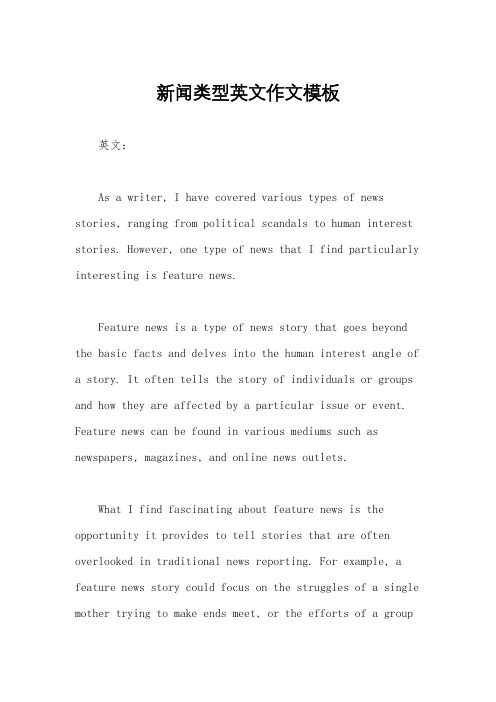
新闻类型英文作文模板英文:As a writer, I have covered various types of news stories, ranging from political scandals to human interest stories. However, one type of news that I find particularly interesting is feature news.Feature news is a type of news story that goes beyond the basic facts and delves into the human interest angle of a story. It often tells the story of individuals or groups and how they are affected by a particular issue or event. Feature news can be found in various mediums such as newspapers, magazines, and online news outlets.What I find fascinating about feature news is the opportunity it provides to tell stories that are often overlooked in traditional news reporting. For example, a feature news story could focus on the struggles of a single mother trying to make ends meet, or the efforts of a groupof volunteers to help the homeless in their community. These stories not only inform readers but also provide a deeper understanding of the human experience.Another aspect of feature news that I appreciate is the creative freedom it allows. Unlike traditional news reporting, feature news allows writers to use theircreativity to tell a story in a way that is engaging and thought-provoking. This can include the use of descriptive language, quotes, and anecdotes to bring the story to life.Overall, feature news is a type of news that I enjoy writing about because it allows me to tell stories that are often overlooked in traditional news reporting. It also provides the opportunity to use my creativity to engage readers and provide a deeper understanding of the human experience.中文:作为一名作家,我已经涵盖了各种类型的新闻报道,从政治丑闻到人文故事。
【文献综述】An Analysis of Language Features of English News Headlines

文献综述英语An Analysis of Language Features of English NewsHeadlines1. Situation of the ResearchA news headline is the “soul” of an article which gives an immediate revelation of its essence. A good headline can not only attract the readers’ attention, trigger their desire to read but also help them to grasp the main points of the news. Since the special function of news story in our society currently, many scholars from all over the world have paid their focus on the study of news. Through their hardworking, there have been a lot of valuable investigation, theories and approaches applied for further study in future. Moreover, the study of news headline has been a tradition and trend in the realm of news research, which is because news headline is playing a unique role in the whole article (Reah, D. 2002: 13-19). Now, researches on news headlines abroad and at home have made continuous achievements in various aspects.For a longtime, the discussion of news has been the central part of mass media study, which has penetrated into the study of mass communication. In mass communication, there are three basic elements: the sender expresses and edits a message by the means of media; medium is the device of passing the information through time and space; and the receiver is the individual to whom the message is directed (Bell. A. 1991:78). According to these theoretical basics, news headlines are the essence of message that the sender wants to tell the readers. From this point, the special importance of news headlines is obvious to be seen. The best and most comprehensive work is accounted to Van Dijk’s News analysis. In this book, Van Dijk analyzed over 400 million headlines in the Dutch press reporting about an occasion of radical tension between the Dutch and immigrant groups. Under the context of discourse analysis, he pointed out, the complex ideological implication of headlines. Meanwhile, Van Dijk has advanced that “Undoubtedly, the most prominent feature of news discourse is the headlines(1988: 34). They subjectively express the most important information of the text,that is, the main topic of the semantic macrostructure. They define the situation and, thus, program the reader with a preferred reading and interpretation plan.”Meanwhile, some studies can be seen in some journalists. In 1994, Huang Weihe, published “An Exploration to Types and Linguistic Features of English Headlines” (1999:23). In 1995, Guo Ke carried on the comparative study of features between English and Chinese headlines. In 2001, Shang Yuanyuan compared the impact of variables of context on both generic structure potential and specific language expression from a functional approach by analyzing news headlines (2001:28).2. Existing Problems in the ResearchWith all efforts in the all around research, the thesis achieved some points. But it is really necessary to state that there indeed exist inevitable limitations. It only refers to some most basic issues of the researches of news headline, which ignored some important explorations or developments. Secondly, although this thesis cited some specific news headlines, but the amount is not enough, so it cannot avoid some doubt on the representativeness. Besides, the selected headlines were chosen randomly from the different sections in newspapers including news about world, region, politics, business, education and so on. But the distribution of every section is not so uniform.In the process of writing this paper, maybe it is hard for me to get the useful English materials; I think I can get it from network. During the process of my research, I encountered various problems beyond my ability. In these circumstances, I consulted the teachers; and with their help, I referred to the reference books and materials in library; additionally, discussions with my classmates were also of great value during my research.Experts from both abroad and home have researched the topic deeply, there still leaves much space for improvement in future research. First, a contrastive study in English and Chinese news headlines is untouched. The contrastive study of relevance and presupposition can be studied as a further project. Second, a deep and comprehensive investigation based on a large range o data deserves further study. The research can take a variety of topics ranging from politics, education, sports, entertainment to business. Third, a particular comparative study can be made between different headline sections in newspapers to examine the possible discrepancy in the application n pragmatic theories. It is hoped that this thesis can shed some light on the study of English new headlines from the perspective of pragmatics.3. Orientation of the ResearchIn view of the limitations stated above, it is certain that the present study makes no claim to completeness and leaves much space for improvement in future research. First, a contrastive study in English and Chinese news headlines is untouched. The contrastive study of relevance and presupposition can be studied as a further project. Second, a deep and comprehensive investigation based on a large range o data deserves further study. The research can take a variety of topics ranging from politics, education, sports, entertainment to business. Third, a particular comparative study can be made between different headline sections in newspapers to examine the possible discrepancy in the application n pragmatic theories. It is hoped that this thesis can shed some light on the study of English new headlines from the perspective of pragmatics. Meanwhile, apart from new headlines, there are other types of titles for discourses. More or less, they have some features in common. Therefore, understanding the features of news headline will help us to understand other types of titles, too.The translation of journalistic English including English news headline plays a crucial role in the public affairs of our country as well as in our daily work and life, for it can bring us a great deal of latest information of the world, almost including every field of life. Because of this, we can learn and understand the advanced and advantageous information in the world. Though the translation of news reporting is very valuable, it is really a hard task to fulfill. It requires special translation strategies because journalistic English is quite different from English of other styles. Therefore, the author introduces some strategies for translating English news headlines and gives some examples. On the whole, we can understand better, knowing the features of the English news headline. What’s more, we could translate the headline in a proper way form learning it. The strategies of translation are based on the headline features. Through using some techniques, we could translate the headline better.A headline is the fundamental part of any news. Its language features are so different from those of news that it is often seen as a special kind of style and discussed separately. Generally speaking, a good headline is characterized by conciseness, originality and attractiveness. It is probably for this reason that beginners to journalistic English have no ideaof what the report says at the first sight of its headlines and feel it difficult to comprehend and translate the headlines. But if they get into a full knowledge of the features of English news headlines, it will not be a big problem to understand and translate English news headlines. 4. Process of the ResearchOwing to the increasingly frequent international communication, English newspaper becomes more and more prevalent. News headlines, the condensed essence of news, are helpful for people to get news in formation. Thus, the study of it is not only necessary but also urgent.First phase( -- ):Actively collect, gather and analyze relevant academic materials, carefully read the materials on hands and choose the most useful essays to finally makea preliminary summery toward this topic of An Analytic Study on the LanguageFeatures of English News HeadlinesSecond phase(- ):Further comb the related academic materials and essays, find out the focuses of this topic to form opinions and collect all the arguments for this essay, form the basic frame of this essay and create the first draft.Third phase(- ):Carefully correct, fulfill, perfect and improve the essay under the guidance of the tutor to form the second draft. Hand this draft to the tutor for a checkout. Fourth phase():Checking and finding out the mistakes, adding what is still needed and to be prepared for the final draft.5. Works Cited[1] Bell. A. The Language of News Media [M]. Cambridge: Blackwell, 1991:78.[2] Crowell, Alfred A. Creative News Editing[M]. Dubuque: Brown Company Publishers,1975: 112.[3] Danuta R. The Language of Newspapers [M]. London: Routledge, 2002: 57.[4] Merriam Webster, Webster’s Third New International Dictionary [M]. Washington:Merriam Webster Inc, 1976: 243.[5] New York time [N]. New York: New York Press, 2007.[6] Reah, D. Newspapers [M]. London: Routledge, 2002: 13-19.[7] Thompson, G. Introducing Functional Grammar [M]. Beijing: Foreign Language andResearch Press, 2001.[8] Twenty-first century [J]. Beijing: China Daily Press, 2007.。
大学英语作文新闻
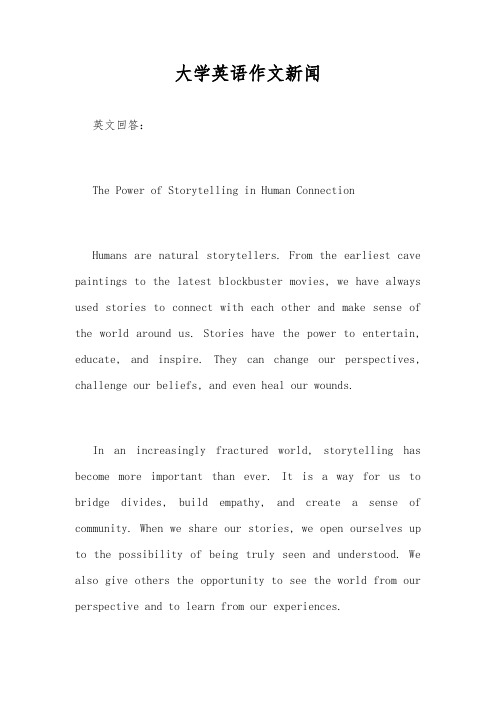
大学英语作文新闻英文回答:The Power of Storytelling in Human ConnectionHumans are natural storytellers. From the earliest cave paintings to the latest blockbuster movies, we have always used stories to connect with each other and make sense of the world around us. Stories have the power to entertain, educate, and inspire. They can change our perspectives, challenge our beliefs, and even heal our wounds.In an increasingly fractured world, storytelling has become more important than ever. It is a way for us to bridge divides, build empathy, and create a sense of community. When we share our stories, we open ourselves up to the possibility of being truly seen and understood. We also give others the opportunity to see the world from our perspective and to learn from our experiences.The power of storytelling is not limited to grand narratives or epic tales. Even the smallest stories can have a profound impact. A personal anecdote, a family legend, or a simple observation can all be used to connect with others and build relationships.The key to effective storytelling is authenticity. People can tell when a story is genuine and heartfelt. When we share our stories from the heart, we invite others to do the same. This creates a cycle of sharing and connection that can lead to deeper understanding and empathy.中文回答:故事的力量在于人类的连接人类是天生的故事家。
广播电视新闻学中英文对照外文翻译文献
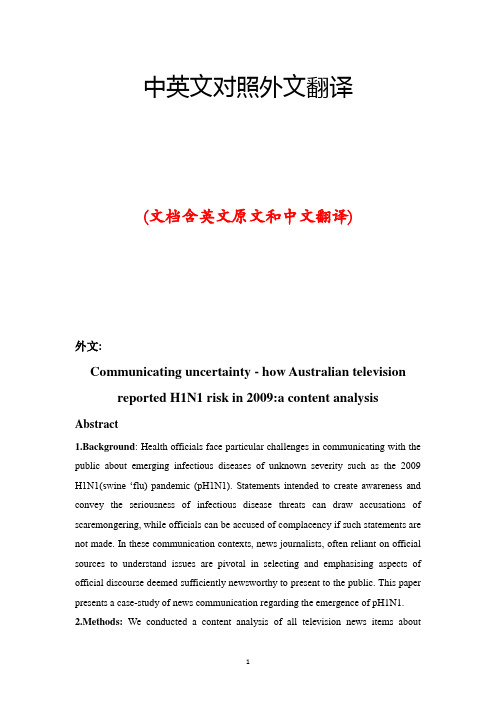
中英文对照外文翻译(文档含英文原文和中文翻译)外文:Communicating uncertainty - how Australian television reported H1N1 risk in 2009:a content analysis Abstract1.Background: Health officials face particular challenges in communicating with the public about emerging infectious diseases of unknown severity such as the 2009 H1N1(swine …flu) pandemic (pH1N1). Statements intended to create awareness and convey the seriousness of infectious disease threats can draw accusations of scaremongering, while officials can be accused of complacency if such statements are not made. In these communication contexts, news journalists, often reliant on official sources to understand issues are pivotal in selecting and emphasising aspects of official discourse deemed sufficiently newsworthy to present to the public. This paper presents a case-study of news communication regarding the emergence of pH1N1.2.Methods: We conducted a content analysis of all television news items aboutpH1N1. We examined news and current affairs items broadcast on 5 free-to-air Sydney television channels between April 25 2009 (the first report) and October 9 (prior to the vaccine release) for statements about the seriousness of the disease how the public could minimise contagion government responses to emerging information.3.Results: pH1N1 was the leading health story for eight of 24 weeks and was in the top 5 for 20 weeks. 353 news items were identified, yielding 3086 statements for analysis, with 63.4% related to the seriousness of the situation, 12.9% providing advice for viewers and 23.6% involving assurances from government. Coverage focused on infection/mortality rates, the spread of the virus, the need for public calm, the vulnerability of particular groups, direct and indirect advice for viewers, and government reassurances about effective management.4.Conclusions: Overall, the reporting of 2009 pH1N1 in Sydney, Australia was generally non-alarmist, while conveying that pH1N1 was potentially serious. Daily infection rate tallies and commentary on changes in the pandemic alert level were seldom contextualised to assist viewers in understanding personal relevance. Suggestions are made about how future reporting of emerging infectious diseases could be enhanced.BackgroundIn recent years , Australians have been exposed to a range of large – scale news coverage and health promotion campaigns about communicable disease. These have included seasonal influenza advisories; campaigns promoting immunisation for vaccine-preventable diseases; traveller vaccination messages; sexually transmitted disease prevention campaigns, including human papilloma virus vaccine to prevent cervical cancer ; HIV/AIDS and hepatitis B and C prevention. With the exception of HIV/AIDS and sexually-transmitted diseases, each of these has a vaccine and clear directives about how to avoid infection, forming the central communicative focus of such campaigns.The WHO-declared global pH1N1 (swine …flu) pandemic of 2009 has attractedresearch attention from virologists and infectious disease specialists, but less from communication scholars. From the first reports of Mexican cases in late April 2009, what would become sustained Australian reportage rapidly turned to the likelihood of Australian cases involving perhaps epidemic and high mortality numbers. Australians were exposed to daily news featuring the country‟s senior health officials and an array of infectious disease experts, who unavoidably, had to deal with the uncertain and complex trajectories and virulence of the disease in the context of news production cultures characterized by seven second sound-bites and an appetite for unambiguous , easily understood information.MethodsSince May 2005, the Australian Health News Research Collaboration has recorded and categorised all news, current af fairs and …infotainment‟ programmes related to health and medicine on Sydney free-to-air television stations . We searched the AHNRC database and included all items tagged with …H1N1‟ or …swine flu‟ in the period April 25, 2009 (the first mention) until October 9 2009. All stories were video clips which were used for the content analysis reported here. Using a list of content categories that emerged progressively from the content as the pH1N1 story evolved, two authors (AF and MI) compared coding on a set of 15 random clips that each watched and coded individually. After resolving any coding differences and agreeing upon how particular items should be handled, they coded the remainder of the items. These categories related to statements made regarding [1] the seriousness of H1N1, [2] recommended actions viewers were advised to take about avoiding contracting or spreading pH1N1, and [3] reassurances that the government was handling the situation. A statement was any direct (X said “Y”) or attributed ("X said that...”) quote by the journalists or news actors featured in each item. A test of inter-coder reliability produced a Kappa statistic of 0.63, indicating a good level of agreement.The role of the Internet as a platform for delivering public health interventions to specific patient groups and to the general public is constantly increasing, due in particular to its disseminating potential: the worldwide penetration of the Internet isincreasing and the use of this medium for seeking health information is frequent . Moreover, the Internet potential for individual tailoring and interactivity is superior to that of other high reach-delivery channels .ResultsA total of 353 news stories were identified, containing 3,086 statements related to the three key areas of inquiry. During the 24 weeks reported here, pH1N1 was the leading health story for eight weeks and for 20weeks remained in the top five most frequently reported health stories. We also note that the virus was rarely referred to by the name pH1N1 during the coverage and instead, was routinely termed swine …flu . When reporting exact quotes we have therefore retained the term swine …flu.(1)Seriousness Of pH1N1Of all statements , 63. 4% (n = 1, 958 /3 ,0 86 ) related to the seriousness of pH1N1 . This was communicated via four recurring stories : (i) daily tallies of infection and mortality ; ( ii ) des- criptions of spread of the virus; (iii) the need for calm responses; and (iv) the vulnerability of particular groups. We briefly summarise other statements which did not comprise significant proportions of the coverage, but may have been important to those who incidentally saw some news stories. This included similarities between pH1N1 and other viruses, government management plans, and the need for systems covering diagnosis and the anticipated vaccine roll out.(2)Advice And Recommended Actions For ViewersIn more than one third of stories (n = 131/353 - 37%) direct or indirect advice was given on what viewers could do to prevent spreading infection . However, these statements accounted for just 12.9% (n =399/3,086) of all statements. Just over a quarter (27.8%,n = 111/399) focused on basic personal hygiene, another quarter related to preventing infection by being mindful of issues of proximity (27.8%, n = 111/399) and a fifth advised seeing a doctor and seeking further information (20.6%, n = 82/399).(3)Reassurance That Government Was Handling The SituationOf all statements recorded , 23.6 % ( n = 7 2 9 / 3 , 0 8 6 )assured viewers that the government was handling the situation by elaborating on its current and proposed actions.About a third of these statements ( 2 9 . 8 % , n = 2 1 7 /7 2 9 ) referred to the immediate need for the Government to develop, test and then distribute a vaccine starting with priority groups.A quarter of these statements ( 2 5 . 9 % , n = 1 8 9 / 7 2 9 )reassured the public that the government was putting significant effort into border control measures designed to prevent pH1N1 entering Australia, and following up and containing detected infection. These statements generally concerned quarantine measures , the use of thermal imaging at airports or statements about new measures and ongoing monitoring of the situation。
国内外经济新闻英语作文
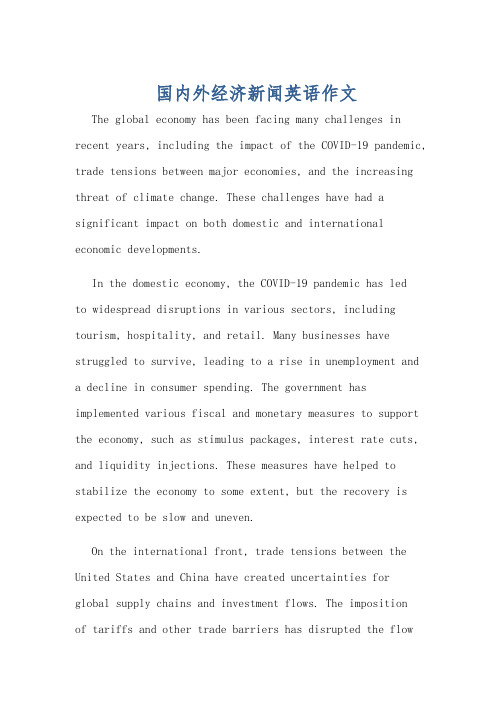
国内外经济新闻英语作文The global economy has been facing many challenges in recent years, including the impact of the COVID-19 pandemic, trade tensions between major economies, and the increasing threat of climate change. These challenges have had a significant impact on both domestic and international economic developments.In the domestic economy, the COVID-19 pandemic has ledto widespread disruptions in various sectors, including tourism, hospitality, and retail. Many businesses have struggled to survive, leading to a rise in unemployment and a decline in consumer spending. The government has implemented various fiscal and monetary measures to support the economy, such as stimulus packages, interest rate cuts, and liquidity injections. These measures have helped to stabilize the economy to some extent, but the recovery is expected to be slow and uneven.On the international front, trade tensions between the United States and China have created uncertainties forglobal supply chains and investment flows. The impositionof tariffs and other trade barriers has disrupted the flowof goods and services, leading to higher costs for businesses and consumers. In addition, the increasingthreat of climate change has raised concerns about thelong-term sustainability of economic growth. Extreme weather events and natural disasters have causedsignificant damage to infrastructure and production facilities, posing a threat to global economic stability.Despite these challenges, there are also opportunities for economic growth and development. The rapid advancement of technology and digitalization has created new opportunities for businesses to expand their operations and reach new markets. The shift towards renewable energy and sustainable practices has also created new industries and job opportunities. Furthermore, the increasing trend towards globalization and interconnectedness has created opportunities for international cooperation and collaboration in addressing common challenges.In conclusion, the domestic and international economy is facing a multitude of challenges, but there are also opportunities for growth and development. It is important for governments, businesses, and individuals to worktogether to address these challenges and seize the opportunities for a more sustainable and inclusive economic future.全球经济近年来面临许多挑战,包括新冠疫情的影响、主要经济体之间的贸易紧张关系以及日益严重的气候变化威胁。
新闻英语翻译研究文献综述

新闻英语翻译研究文献综述新闻英语,即“新闻报道文章中所使用的英语,具有新闻特性、适合新闻报道要求、适应新闻信息传播需要的语言”(张建,2004),成为了对外宣传的重要工具,特别是进入新世纪以来,对新闻翻译这一领域的关注日益增强,近年来,我国学者关于这方面的研究也逐渐逐渐多元化,从现有文献来看,主要集中在新闻本身的文体特点及翻译方法、新闻翻译理论、新闻翻译原则等方面。
1 新闻文体特点及翻译方法的研究文献综述徐泉、王婷(2001)总结出新闻文体的如下特点:1.用词新颖,精巧别致;2.句式多样富于弹性;3.巧用时态,布局呼应;4.频繁使用被动语态,重点突出;5.结构合理层次分明;6.善用修辞,讲求效果。
就语法层面的翻译而言,李侠(2004)分析了英语新闻句子的四大特点:1.信息量大;2.结构简单; 3.语法手段丰富;4.名词修饰语前置。
李认为在翻译英语新闻时,必须遵循汉英两种语言的规律和使用习惯,努力增强译作的准确性和可读性,并提出了英语新闻句子汉译的3种方法: 1.化长为短; 2.调整句子中各部分的顺序与敢减敢删;3.使用四字格结构。
曾尼(2010)从新闻英语的标题、词汇和时态及语态的角度,论述了新闻英语的一些文体特征。
比如,由于报刊篇幅有限,新闻事件在语法方面的一个重要特点就是句型的高度扩展,结构严谨,句式简短精练,语言简洁是受人们称赞并为人们所追求的风格。
郑连勋、郑堃(2011)认为新闻英语的问题与其他形式的新闻问题相同,拥有许多属于自己的独特语言。
在理解其用词特点的基础上面,代词、复合词、外来词等应用方式,也是新闻英语用词方面的关键,从英语新闻报道展开分析,以借代词、引申词、复合词、外来词、小词语缩略词、临时造词等方面为例探讨了英语新闻当中的用词特点。
不少学者就这些文体特点的翻译进行了单项阐述。
王治江(2001)提出了新闻外来词语音译中应注意的原则,即人名和地名中翻译要统一,不仅要译出指称意义,还要译出联想意义,但要避免产生贬义联想。
国外新闻 英文读物
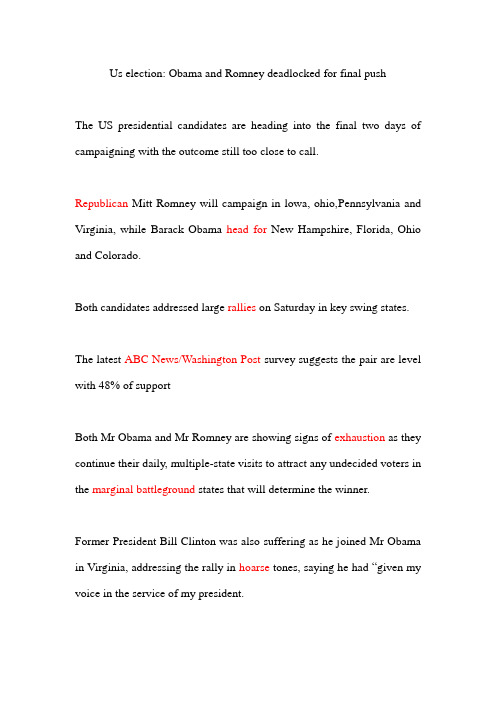
Us election: Obama and Romney deadlocked for final pushThe US presidential candidates are heading into the final two days of campaigning with the outcome still too close to call.Republican Mitt Romney will campaign in lowa, ohio,Pennsylvania and Virginia, while Barack Obama head for New Hampshire, Florida, Ohio and Colorado.Both candidates addressed large rallies on Saturday in key swing states.The latest ABC News/Washington Post survey suggests the pair are level with 48% of supportBoth Mr Obama and Mr Romney are showing signs of exhaustion as they continue their daily, multiple-state visits to attract any undecided voters in the marginal battleground states that will determine the winner.Former President Bill Clinton was also suffering as he joined Mr Obama in Virginia, addressing the rally in hoarse tones, saying he had “given my voice in the service of my president.Mr Obama told the 24.000 people in Bristow, Virginia, that the planning and organization of his campaign now no longer mattered.At Mr Obama rally in Milwaukee, pop star Katy Perry, wearing a dress emblazoned with the Democatic slogan“Forward”,helped warm up a o20,000 crowd.Mr Obama told them not to allow Mr Romney to return the US to a time when Wall St had “free rein to do whatever” it liked.Wall St - Wall St Designed by Kexin Zhao 华尔街在纽约市曼哈顿区Love of countryCampaigning in New Hampshire on Saturday, Mr Romny criticized Mr Obama for saying that voting would be their “best revenge” on the republicans.Later, in Colorado springs , the republican challenger told supporters that Tuesday’s election would be “ a moment to look into the future, and imagine what we can do to put the past four years behind us .We are that close right now he said the door to a brighter future is there.The BBC’s Bridget Kendall, in the bellwether state of Ohio, says the campaigning there has been at its fiercest. No republication has ever been elected president without first winning Ohio.But, she asks, when there has been so much pressure on people to vote early and when all but a tiny fraction of likely voters have made up their mind, how much difference will all this frantic last-minute campaigning have?Speaking to our correspondent, two voters echoed the country’s split on the candidates.Defence contractor Derek Maddox said :“I …ll be voting for Mr Romnry …at least he has a plan, for turning the economy round and getting jobs. He‟s proved he can do it many, many times.However , retired teacher Anita Hidegren, a registered republican, said she would vote for Mr Obama:“maybe not everything got done ,but a lotAn opinion poll on Sunday for ABC News and the Washington Post put the two candidates at 48%, with even voters who term themselves independents split evenly on 46%.。
英语新闻文献总结范文

In the past few weeks, a variety of English news reports have been published, covering a wide range of topics. This summary aims to provide an overview of some of the most significant news stories and their implications.1. The Global PandemicThe ongoing COVID-19 pandemic remains a central focus of English news reports. With new variants emerging and vaccination rates varying across different regions, the impact of the pandemic continues to be felt worldwide. Recent reports have highlighted the challenges faced by healthcare systems, the economic impact of lockdown measures, and the search for effective treatments and vaccines.2. Climate Change and Environmental IssuesThe issue of climate change has also been a major topic in English news reports. With increasing frequency and severity of natural disasters, such as hurricanes, floods, and wildfires, the urgency of addressing climate change has become more apparent. Reports have focused on the need for international cooperation, the importance of renewable energy sources, and the impact of climate change on vulnerable populations.3. Political EventsPolitical events have continued to shape the English news landscape. From the US midterm elections to the UK's Brexit negotiations, political news has captured the attention of many. Reports have explored the outcomes of these events, their implications for global politics, and the potential for future conflict or cooperation.4. Social IssuesSocial issues have also been a significant source of news. Recent reports have focused on topics such as racial inequality, gender equality, and mental health. These stories have highlighted the challenges faced by marginalized groups and the importance of addressing these issues to create a more inclusive and equitable society.5. Technology and InnovationThe rapid development of technology and innovation has been another key area of interest in English news reports. From the rise of artificial intelligence to the growing importance of cybersecurity, reports have explored the potential benefits and risks associated with these advancements. Additionally, the impact of social media on news dissemination and public opinion has also been a topic of discussion.In conclusion, the recent English news reports have covered a diverse range of topics, reflecting the complexity and interconnectedness of the world we live in. These stories have provided valuable insights into the challenges and opportunities that lie ahead, and have encouraged us to think critically about the issues that affect our lives. As we continue to navigate this ever-changing world, it is important to stay informed and engaged with the news, so that we can make informed decisions and contribute to positive change.。
新闻文体英语作文
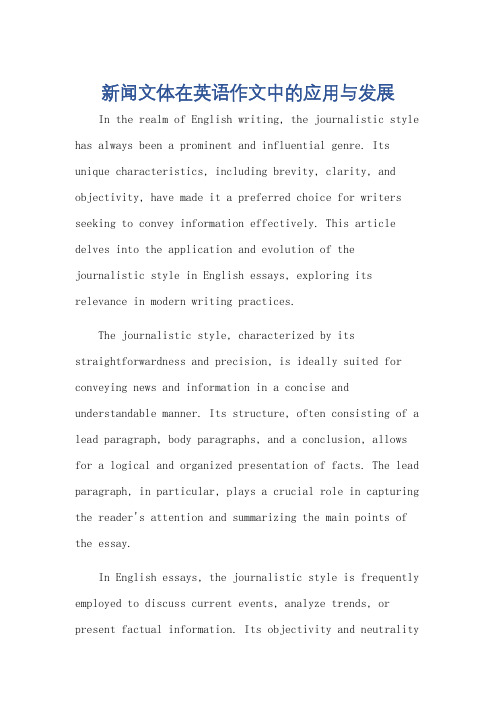
新闻文体在英语作文中的应用与发展In the realm of English writing, the journalistic style has always been a prominent and influential genre. Its unique characteristics, including brevity, clarity, and objectivity, have made it a preferred choice for writers seeking to convey information effectively. This article delves into the application and evolution of thejournalistic style in English essays, exploring its relevance in modern writing practices.The journalistic style, characterized by its straightforwardness and precision, is ideally suited for conveying news and information in a concise and understandable manner. Its structure, often consisting of a lead paragraph, body paragraphs, and a conclusion, allows for a logical and organized presentation of facts. The lead paragraph, in particular, plays a crucial role in capturing the reader's attention and summarizing the main points of the essay.In English essays, the journalistic style is frequently employed to discuss current events, analyze trends, or present factual information. Its objectivity and neutralityallow for a balanced and unbiased presentation of facts, making it a valuable tool for writers seeking to inform rather than persuade their audience.The evolution of the journalistic style in English writing can be traced back to the rise of the printing press and the subsequent development of newspapers and magazines. Over time, the style has adapted to changing media formats and reader preferences, evolving to become more concise, accessible, and visually appealing.In modern times, the journalistic style has beenfurther influenced by the rise of digital media and the demands of online readers. This has led to a focus on shorter, snappier writing that can be easily digested on screens. At the same time, the need for accuracy and verification has become even more crucial in the age of information overload.The application of the journalistic style in English essays is not limited to traditional news reporting. It can also be effectively used in academic writing, where the ability to communicate complex ideas clearly and concisely is paramount. By employing the journalistic style, academicwriters can enhance the readability and impact of their work, making it more accessible to a wider audience.Moreover, the journalistic style can be a valuable tool for English language learners. By analyzing and模仿journalistic writing, learners can improve their understanding of the language's structure, vocabulary, and syntax. This, in turn, can help them develop their own writing skills and enhance their ability to communicate effectively in English.In conclusion, the journalistic style remains a vital and relevant genre in English writing. Its adaptability and versatility make it suitable for a wide range of writing tasks, from news reporting to academic writing. As themedia landscape continues to evolve, the journalistic style will likely continue to adapt and evolve, maintaining its relevance in the world of English writing.**新闻文体在英语作文中的应用与发展**在英语写作领域,新闻文体一直是一个突出且有影响力的体裁。
英美报刊选读(辅修) 参考文献
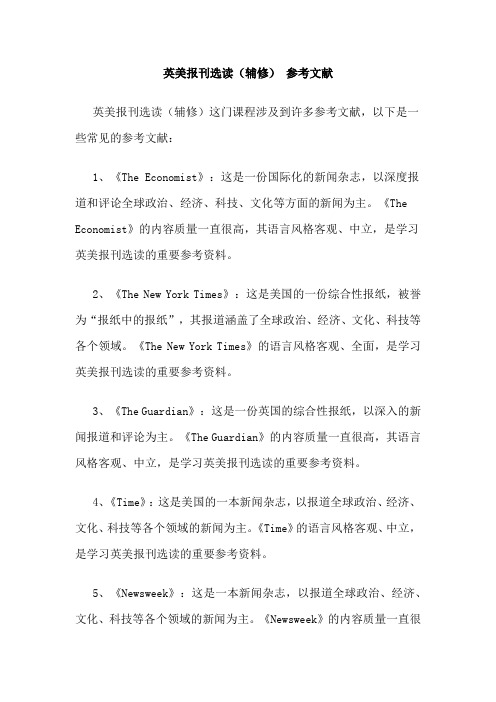
英美报刊选读(辅修)参考文献英美报刊选读(辅修)这门课程涉及到许多参考文献,以下是一些常见的参考文献:1、《The Economist》:这是一份国际化的新闻杂志,以深度报道和评论全球政治、经济、科技、文化等方面的新闻为主。
《The Economist》的内容质量一直很高,其语言风格客观、中立,是学习英美报刊选读的重要参考资料。
2、《The New York Times》:这是美国的一份综合性报纸,被誉为“报纸中的报纸”,其报道涵盖了全球政治、经济、文化、科技等各个领域。
《The New York Times》的语言风格客观、全面,是学习英美报刊选读的重要参考资料。
3、《The Guardian》:这是一份英国的综合性报纸,以深入的新闻报道和评论为主。
《The Guardian》的内容质量一直很高,其语言风格客观、中立,是学习英美报刊选读的重要参考资料。
4、《Time》:这是美国的一本新闻杂志,以报道全球政治、经济、文化、科技等各个领域的新闻为主。
《Time》的语言风格客观、中立,是学习英美报刊选读的重要参考资料。
5、《Newsweek》:这是一本新闻杂志,以报道全球政治、经济、文化、科技等各个领域的新闻为主。
《Newsweek》的内容质量一直很高,其语言风格客观、中立,是学习英美报刊选读的重要参考资料。
6、《Reader's Digest》:这是一本读者文摘的杂志,它汇集了许多新闻和故事。
《Reader's Digest》的语言风格通俗易懂,适合用来帮助提高英语阅读能力和阅读兴趣。
7、《英语学习笔记》:这是一本由英语专家编写的英语学习教材,涵盖了英语学习的各个方面。
《英语学习笔记》的内容质量很高,可以帮助学习者系统地提高英语阅读和写作能力。
8、《英美报刊选读》:这是一本由国内英语专家编写的英美报刊选读教材,涵盖了英美报刊阅读技巧和相关背景知识的介绍。
《英美报刊选读》的内容质量很高,可以帮助学习者提高对英美报刊阅读的理解和分析能力。
新闻英语翻译研究文献综述
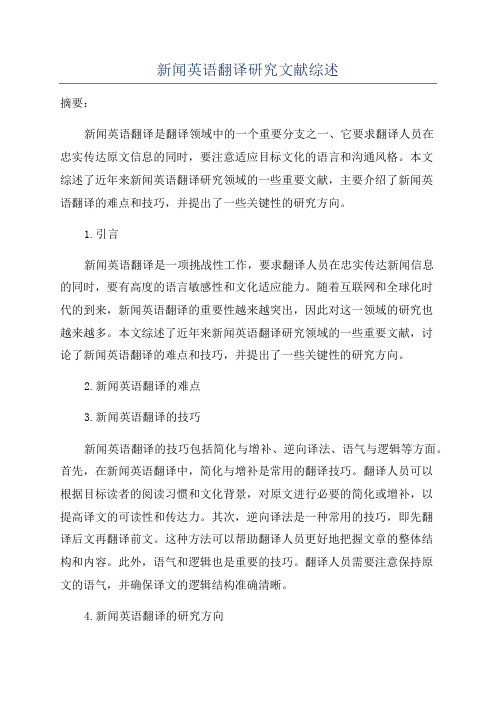
新闻英语翻译研究文献综述摘要:新闻英语翻译是翻译领域中的一个重要分支之一、它要求翻译人员在忠实传达原文信息的同时,要注意适应目标文化的语言和沟通风格。
本文综述了近年来新闻英语翻译研究领域的一些重要文献,主要介绍了新闻英语翻译的难点和技巧,并提出了一些关键性的研究方向。
1.引言新闻英语翻译是一项挑战性工作,要求翻译人员在忠实传达新闻信息的同时,要有高度的语言敏感性和文化适应能力。
随着互联网和全球化时代的到来,新闻英语翻译的重要性越来越突出,因此对这一领域的研究也越来越多。
本文综述了近年来新闻英语翻译研究领域的一些重要文献,讨论了新闻英语翻译的难点和技巧,并提出了一些关键性的研究方向。
2.新闻英语翻译的难点3.新闻英语翻译的技巧新闻英语翻译的技巧包括简化与增补、逆向译法、语气与逻辑等方面。
首先,在新闻英语翻译中,简化与增补是常用的翻译技巧。
翻译人员可以根据目标读者的阅读习惯和文化背景,对原文进行必要的简化或增补,以提高译文的可读性和传达力。
其次,逆向译法是一种常用的技巧,即先翻译后文再翻译前文。
这种方法可以帮助翻译人员更好地把握文章的整体结构和内容。
此外,语气和逻辑也是重要的技巧。
翻译人员需要注意保持原文的语气,并确保译文的逻辑结构准确清晰。
4.新闻英语翻译的研究方向新闻英语翻译的研究方向主要包括新闻翻译理论、翻译策略和技术应用等方面。
首先,新闻翻译理论的研究是这一领域的基础。
研究者可以通过对新闻英语翻译历史和实践的分析,总结出一些适用于新闻翻译的理论模式和方法。
其次,翻译策略的研究可以帮助翻译人员更好地解决新闻翻译中的难题。
研究者可以根据不同的语言风格、文化差异和传播目的,提出适用于新闻翻译的实际策略。
最后,技术应用的研究可以通过计算机辅助翻译系统等工具,提高新闻英语翻译的效率和质量。
总结:新闻英语翻译是翻译领域中的一个重要分支,它要求翻译人员在忠实传达原文信息的同时,注意适应目标文化的语言和沟通风格。
新闻敏感的变化英文作文
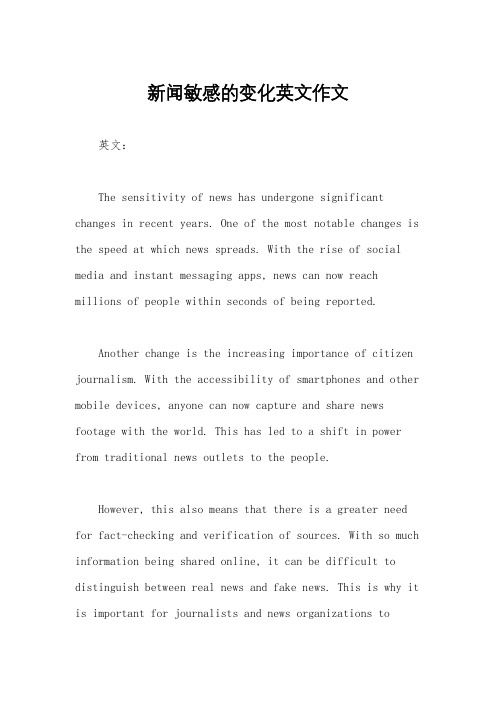
新闻敏感的变化英文作文英文:The sensitivity of news has undergone significant changes in recent years. One of the most notable changes is the speed at which news spreads. With the rise of social media and instant messaging apps, news can now reach millions of people within seconds of being reported.Another change is the increasing importance of citizen journalism. With the accessibility of smartphones and other mobile devices, anyone can now capture and share news footage with the world. This has led to a shift in power from traditional news outlets to the people.However, this also means that there is a greater need for fact-checking and verification of sources. With so much information being shared online, it can be difficult to distinguish between real news and fake news. This is why it is important for journalists and news organizations tomaintain their credibility and integrity.In addition, the sensitivity of news has also become more apparent in terms of the impact it can have on individuals and communities. With the rise of socialjustice movements and the #MeToo movement, for example, there is a greater awareness of the harm that can be caused by insensitive or biased reporting.Overall, the sensitivity of news has evolved in response to changes in technology, society, and culture. It is important for journalists and news organizations to adapt to these changes and maintain their commitment to accuracy, fairness, and respect for their subjects.中文:新闻的敏感性在近年来发生了重大变化。
关于社会新闻的英语文章
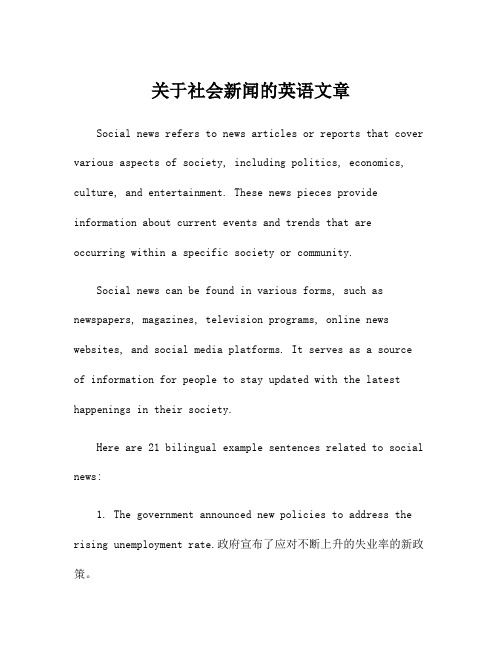
关于社会新闻的英语文章Social news refers to news articles or reports that cover various aspects of society, including politics, economics, culture, and entertainment. These news pieces provide information about current events and trends that are occurring within a specific society or community.Social news can be found in various forms, such as newspapers, magazines, television programs, online news websites, and social media platforms. It serves as a source of information for people to stay updated with the latest happenings in their society.Here are 21 bilingual example sentences related to social news:1. The government announced new policies to address the rising unemployment rate.政府宣布了应对不断上升的失业率的新政策。
2. The prime minister's visit to the earthquake-stricken region attracted international attention.首相对地震灾区的访问引起了国际关注。
英文版新闻报道.doc

英文版新闻报道常见的四类英文新闻稿类型及写作模版要点企业社会责任/赞助类CSR-Sponsorship新闻稿标题:[COMPANY] to Team with [PARTNER] to [EVENT GOAL]典型新闻稿举例:Mary J Blige Joins Forces with Belvedere Vodka and to Help Save LivesMoet& Chandon and Filmaid As i a Announces the Power of Film Gala正文Feb. 23, 20116 /PRNewswire-Asia/—[C O O MPANY NAME], a leader in[INDUSTRY], is joiningf o o rces with [PARTNER NAME]to help [EVENT GOAL] by [EVENT DETAILS]. Proceeds from the event will go t owards the [FOUNDATION/C H H ARITY NAME] which will[F F OUNDATION/CHARITY GOAL].[MORE EVENT DETAILS & PAR T T ICIPANTS][QUOTE FROM PA R R TICIPANT/PARTNER][COMPA N N Y QUOTE][PARTNER BOILER][COMPANY BOILER][CONTA C C T DETAILS]新产品发布类New Pr o o duct新闻稿标题[COMPANY] Rel e e ases [PRODUCT NAME] to [P P RODUCT FUNCTION]典型新闻稿举例::Wondershare Unveils Pow e e rsketch iPhone App; Turn s s Any Image Into A SketchMasterpiece – Free for 5 D D aysAdfonic Brings Rich M M edia Mobile Ads to the M a a ss Market正文BEIJING, Fe b b. 23, 2016 /PRNewswire-A s s ia/ —[COMPANY NAME], a l eader in [INDUSTRY], ha s s unveiled [NEW PRODUCT], a [PRODUCT DESCRIPTION].[PRODUCT DETAILS][QUOTE FROM CORPORATE EXECUTIVE][MORE INFORMATION ABOUT PRODUCT][COMPANY BOILE R R][CONTACT DETAILS]三)在线零售类Online Retail新闻稿标题::[COMPANY] Offers Great D D eal on Its [PRODUCT] for [EVENT]典型新闻稿举例:Milanoo Announces Spring Fashion Bags –Prices As Low As $Milanoo Expresses Its Ho n n est Greetings to All Lov e e rs on Valentine’s Day正文Feb. 23, 2016 /PRNewswire-Asia/—[COMPANY NAME], a a leading producer/retail e e r of[PRODUCT TYPE] is a n n nouncing a new promotion to [PROMITIOPN REASON / E E VENT] by[PROMOTION DETA L L S].[PRODUCT DESCRIPTION][COMPANY QUOTES / PROM O O TIONAL INFORMATION][PRO M M OTION DETAILS / RESTRICT I ONS][COMPANY BOILER][C C ONTACT DETAILS]篇一:英语新闻报道道的结构英语新闻报道的结构一.新闻标题head l ine标题短而精,不好懂。
新闻报道范文
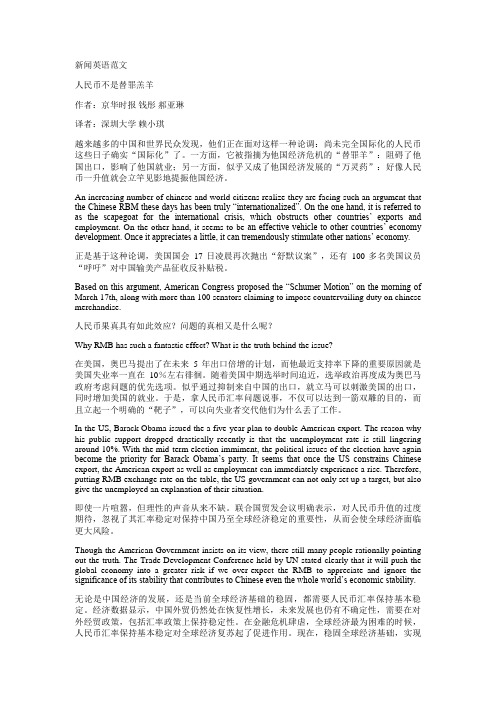
新闻英语范文人民币不是替罪羔羊作者:京华时报钱彤郝亚琳译者:深圳大学赖小琪越来越多的中国和世界民众发现,他们正在面对这样一种论调:尚未完全国际化的人民币这些日子确实“国际化”了。
一方面,它被指摘为他国经济危机的“替罪羊”:阻碍了他国出口,影响了他国就业;另一方面,似乎又成了他国经济发展的“万灵药”:好像人民币一升值就会立竿见影地提振他国经济。
An increasing number of chinese and world citizens realize they are facing such an argument that the Chinese RBM these days has been truly “internationalized”. On the one hand, it is referred to as the scapegoat for the international crisis, which obstructs other countries’ exports and employment. On the other hand, it seems to be an effective vehicle to other countries’ economy development. Once it appreciates a little, it can tremendously stimulate other nations’ economy.正是基于这种论调,美国国会17日凌晨再次抛出“舒默议案”,还有100多名美国议员“呼吁”对中国输美产品征收反补贴税。
Based on this argument, American Congress proposed the “Schumer Motion” on the morning of March 17th, along with more than 100 senators claiming to impose countervailing duty on chinese merchandise.人民币果真具有如此效应?问题的真相又是什么呢?Why RMB has such a fantastic effect? What is the truth behind the issue?在美国,奥巴马提出了在未来5年出口倍增的计划,而他最近支持率下降的重要原因就是美国失业率一直在10%左右徘徊。
英语新闻总结范文
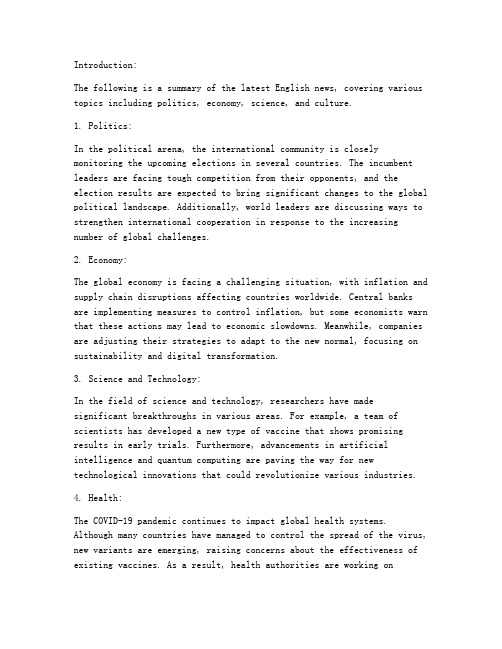
Introduction:The following is a summary of the latest English news, covering various topics including politics, economy, science, and culture.1. Politics:In the political arena, the international community is closely monitoring the upcoming elections in several countries. The incumbent leaders are facing tough competition from their opponents, and the election results are expected to bring significant changes to the global political landscape. Additionally, world leaders are discussing ways to strengthen international cooperation in response to the increasing number of global challenges.2. Economy:The global economy is facing a challenging situation, with inflation and supply chain disruptions affecting countries worldwide. Central banks are implementing measures to control inflation, but some economists warn that these actions may lead to economic slowdowns. Meanwhile, companies are adjusting their strategies to adapt to the new normal, focusing on sustainability and digital transformation.3. Science and Technology:In the field of science and technology, researchers have madesignificant breakthroughs in various areas. For example, a team of scientists has developed a new type of vaccine that shows promising results in early trials. Furthermore, advancements in artificial intelligence and quantum computing are paving the way for new technological innovations that could revolutionize various industries.4. Health:The COVID-19 pandemic continues to impact global health systems. Although many countries have managed to control the spread of the virus, new variants are emerging, raising concerns about the effectiveness of existing vaccines. As a result, health authorities are working ondeveloping new treatments and vaccines to combat the virus and protect the population.5. Culture:In the cultural sphere, a significant event has taken place in the world of music. A renowned musician has released a new album that has received widespread acclaim from both critics and fans. The album explores various themes, showcasing the artist's versatility and creativity. Additionally, a major film festival has concluded, with several films winning prestigious awards for their outstanding storytelling and cinematography.Conclusion:The latest English news highlights the dynamic nature of the world, where political, economic, scientific, and cultural developments continue to shape our lives. As we navigate these challenges and opportunities, it is crucial to stay informed and adapt to the changing landscape. The future holds immense potential, and it is up to us to seize the opportunities that arise.。
关于社会新闻的英语文章
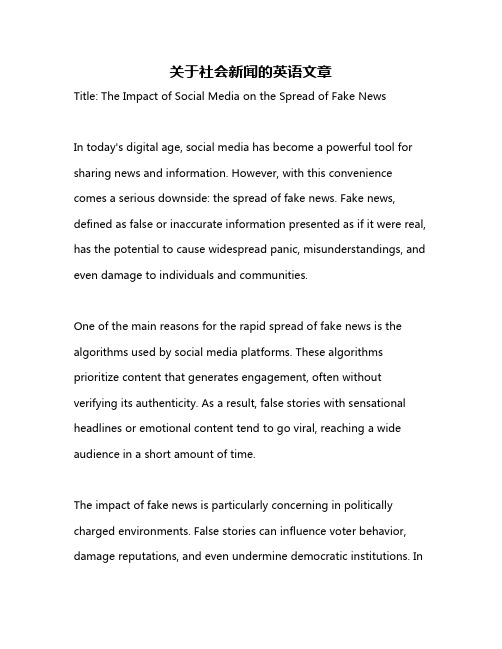
关于社会新闻的英语文章Title: The Impact of Social Media on the Spread of Fake NewsIn today's digital age, social media has become a powerful tool for sharing news and information. However, with this convenience comes a serious downside: the spread of fake news. Fake news, defined as false or inaccurate information presented as if it were real, has the potential to cause widespread panic, misunderstandings, and even damage to individuals and communities.One of the main reasons for the rapid spread of fake news is the algorithms used by social media platforms. These algorithms prioritize content that generates engagement, often without verifying its authenticity. As a result, false stories with sensational headlines or emotional content tend to go viral, reaching a wide audience in a short amount of time.The impact of fake news is particularly concerning in politically charged environments. False stories can influence voter behavior, damage reputations, and even undermine democratic institutions. Inextreme cases, fake news has been linked to violence and hate crimes.To combat the problem of fake news, several strategies can be employed. Firstly, social media platforms need to reevaluate their algorithms to prioritize accurate and verified information. Implementing fact-checking mechanisms and flagging false stories can help curb the spread of misinformation. Additionally, education on media literacy should be emphasized to help individuals identify false news and avoid falling victim to its manipulation.In conclusion, social media's influence on fake news传播 makes it imperative to address this issue seriously. Platforms and individuals alike have a responsibility to ensure the accuracy of information shared, thus protecting the public from the harmful effects of false news.。
- 1、下载文档前请自行甄别文档内容的完整性,平台不提供额外的编辑、内容补充、找答案等附加服务。
- 2、"仅部分预览"的文档,不可在线预览部分如存在完整性等问题,可反馈申请退款(可完整预览的文档不适用该条件!)。
- 3、如文档侵犯您的权益,请联系客服反馈,我们会尽快为您处理(人工客服工作时间:9:00-18:30)。
News Language and the Study of International ReportingJACK Li iJiThe years 1990 and 1991 again confirmed the importance of studies in international reporting. The annual wire service rankings of the top 10 stories of 1990 contained seven international subjects, including Iraq's invasion of Kuwait, the reunification of Germany, and the surrender of Panama's Manuel Noriega.' And with war in the Persian Gulf and revolution in Eastern Europe, 1991 has seen international reporting continue to dominate the news.Recent years have also seen great changes in the practice of journalism around the globe. The Communist press model was discarded in several Eastern European nations, including the Soviet Union, yet governments proved unwilling to relinquish state control.^ U.S. international reporting, especially from the Middle East, has been subjected to increasing censorship from other governments as well as the U.S. military.Death and danger have also marked the years. Reporters were assaulted anddetained in tlae Middle East. In many nations, especially in Latin America, reporters have been kidnapped and slain by those who sought to silence their investigations.-As international events continue to shape the world and journalism, study of international reporting should assume great importance in the journalism curriculum.Students who will never set foot off U.S. soil will need to know key international events, how and why those events are reported, and the implications of those events for the practice of journalism around the world.The purpose of this essay is to present a model outline for the international reporting class. Attempting to incorporate aspects of instruction in comparative media systems as well as analyses of media, it explores the structure of the course and the outcome of its instruction. Specifically, the approach was an analysis of international reporting, rather than a skills course in foreign correspondence. It applied concepts from philosophy, political science, and rhetoric to focus on the language of international news and the reporting process by which a very few global events are selected and crafted into the symbolic form of the news report.The goal was increased understanding of international news. News languagewas defined as journalistic conventions and canon—traditional practices and policies —that structure and shape news reports for both print and broadcast media.Jack Lude is assistant professor of journalism at Lehigh University.Journalism EDUCATOR 66These conventions include the focus and reliance upon events, summary leads, inverted pyramid construction, broadcast stand-ups, use of interviews and official sources, the dominance of political leaders as sources, and the very conception of the news report. Often taken for granted, these conventions, and the ways they are used in global settings, are integral to understanding international reporting.^ This approach —although a difficult philosophical leap for manystudents — was rewarded with deepened insights into the promise and problems of international reporting.Course objectivesDespite their importance, international communication or reporting classes have received little attention in previous research. Several scholars, however, have attempted to incorporate international dimensions into the journalism curriculum.' Along similar lines, interesting research applies insights from anthropology to develop intercultural dimensions in the curriculum."Of course, the global component of a program can be given most depth and attention in a course solely devoted to international journalism. One means of bringing this component to programs is through coursework devoted to foreign correspondence. As the literature suggests, however,not many programs have the resources for such a specific course. Rather, as reflected in important texts, the global component of journalism programs is often conceived as a survey of global media systems and an analysis of issues facing the field.For example, John Merrill's Global Journalism: Survey of International Communication begins with four chapters that provide background and analysis of media philosophy, news fiow, the media systems approach, and current controversies in global communication. The book's second part offers a comprehensive rundown of media systems in six world regions.'Likewise, L. John Martin and Anju Grover Chaudhary, authors of Comparative Mass Media Systems, first provide an overview chapter on the goals and roles of media systems. They then discussed essential issues, such as the nature of news, the use of media as vehicles for education and entertainment, press freedom and media economics —each from the perspective of the Western, Gommunist and Third Worlds."The approach applied here incorporated aspects of the survey course as well as foreign correspondence. The emphasis, however, was on analysis and understanding of the practice of journalism on a global scale. International reporting thus was approached in two ways. It embraced the practice of journalism in individual countries around the world, including a studyof comparative media systems. But it also allowed analysis of the conventions underlying U.S. foreign correspondence.Again, this approach to international reporting promoted study of the language of news and stressed that the language of international news encourages particular events to be reported and in a particular way.From the outset, students applied the thoughts of James Garey to critical study of international reporting: "Press criticism," Garey wrote, "is essentially the criticism of language, it is a vital response on the part of the public to the language the press uses to describe events and to the events that accepted standards of journalistic language allow to be described."*Study of news languageThe course was designed for 15 to 20 journalism and non-journalism majors of junior standingand above, meeting for the usual 50 minutes, three days a week, over a 15-week semester. Because of the large amount of material, organization and pacing were essential. The semester was divided into two parts; each part had two required texts.To study the language of international reporting, students needed to gain sensitivity to and understanding of news conventions. Basic questions were addressed: What gets reported and why? How is it reported and how could it have been reported? Two texts provided a framework: Daniel J. Boorstin's The Image: A Guide to Pseudo Events in America and Murray Edelman's Constructing the Political Spectacle.'"Almost 30 years ago, in The Image, Boorstin provided insights into news conventions that still ring true today. His analyses of pseudo-events, the manufacture and meaning of celebrity, and the process of image making add greatly to understanding reporting, particularly international reporting.In his first chapter, for example, Boorstin discusses pressures that transformed news gathering to news making. He traces the rise of many news conventions, including pseudo-events, interviews, presidential press conferences, press releases, news leaks, and other staples of reporting. Such conventions seek to satisfy the modem era's "extravagant expectations" about "what happens in the world, how much of it is new, and surprising, and important," Boorstin says."Another of Boorstin's important insights is the creation of celebrity. A celebrity, Boorstin says, is a human pseudoevent, "a person who is known for his wellknownness."" Celebrities have replaced heroes, Boorstin argues, and the molding and marketing of celebrity has become an essential part of the political process.For four weeks, students updated Boorstin's analysis and applied his insights to international reporting. For example, examples of broadcast and prestige press coverage of modem international news fixtures, such as summits, conferences, treaty signings, and arms talks were broken down and analyzed from Boorstin's perspective on pseudo-events. His discussion of how news conferences "produce'' news was supported by televised reports on the Gulf War press briefings.Boorstin's insights into how political celebrities can be created by news language were exemplified by U.S. reporting of Mikhail Gorbachev. Clippings from early U.S. press coverage of Gorbachev in newsmagazines were compared to later clippings to reveal the path of his varied celebrity — from media-slick ideologue to far-sighted diplomat to Nobel Peace Prize winner to neo-Stalinist reactionary. Coverage of other international political celebrities, such as George Bush, Lech Walesa, Vaclav Havel and others, was discussed.In the three weeks following, students read Edelman's little book that adds to Boorstin's insights with a sophisticated analysis of political language and the reporting process. Edelman's chapter on the construction and uses of political leaders, for example, was a perfect complement toBoorstin's discussion on the creation of celebrity. "Everyday reporting of the political spectacle systematically reinforces the assumption that leaders are critical to the course of governmentalaction,' Edelman notes. The media, he says, "thrive upon heroes, villains, contests for votes, legislative and judicial victories and defeats, and especially upon the evocation of leaders with whom people can identify or whom they can blame for their discontents.""Edelman also probes a dark side of international reporting. He provides insights into the process by which global enemies can unify political consensus—a process in which reporting is essential. Citing and extending Boorstin's work, Edelman affirms the integral role of news language in constructing such political spectacles. He writes: "It is language about political events, not the events in any other sense, that people experience; even developments that are close by take their meaning from the language that depicts them. So political language is political reality."'*The class compared Edelman's and Boorstin's views on political leaders and again reviewed the newsmagazine coverage of Mikhail Gorbachev. The class applied Edelman's thoughts on political enemies to international news by studying news clippings and television stories offigures such as Khomeini, Noriega, Hussein and others.To finish this section, students pondered the words of George Orwell: "Political language — and with variations this is true of all political parties, from Conservatives to Anarchists — is designed to make lies sound truthful and murder respectable, and to give an appearance of solidity to pure wind."" Students considered the role of news in maintaining and shaping such language.Global journalismIn the second part of the semester, the students then considered the global survey perspective, focusing on international reporting in other countries. Using Merrill's or Martin and Ghaudhary's book, the class devoted four weeks to surveying and comparing media systems, with emphasis on the reporting process and news language. "The raw materials from which the news is fashioned are events that may or may not be readily accessible to all," Martin and Ghaudhary note. "The acts in themselves are not news. They become news when they have been processed by a reporter and editor, much as air and water are not commodities that can be traded commercially until they have been bottled and marketed.""Much time was devoted to current problems in international journalism discussed by the texts. For example, Merrill offers a chapter that traces the continuing struggle over news flow." Students extended the discussion to the emerging role of GNN as a conduit for telediplomacy and examined updated information on the new world information order and U.S. relations with UNESGO. Likewise, the Martin and Ghaudhary text provides three excellent chapters on the conception and practice of international press freedom.'" Students updated these chapters with discussionsof the current status of glasnost and continuing threats to press freedom in Ghina, Latin America, and other regions.Seeking to counter the vertigo that can result from a somewhat breathless survey of world media systems, the class also spent four weeks focussing on media in one particular country—the Soviet Union. Using Ellen Mickiewicz's Split Signals: Television and Politics in the Soviet Union,the class confronted news canon and convention in a very different press system."Mickiewicz analyzes international news on Soviet television, Moscow reporters in Washington, the image of Americans on Soviet television, sources for Soviet newspeople in America and other topics. Using Mickiewicz's analysis and insights from area scholars, the class contrasted U.S. and Soviet news values.Beyond the booksEvery attempt was made to make the subject of international reporting come alive. Throughout the course, readings and discussions were supplemented by outside material. Videotapes that described U.S. network news production were valuable. Students were introduced to beisic technical conventions, such as stand-ups, camera angles, lighting, and the like, which help structure local, national and international news broadcasts.^"Movies and television programs that dealt with international reporting were alsohelpful. For example, clips from Warren Beatty's "Reds,"' which chronicled the lives of correspondents Jack Reed and Louise Bryant as they covered the Russian Revolution, gave the class some fun and flavor. News programs on Mideast hostages led to discussion of the story of Terry Anderson, the Associated Press chief Middle East correspondent, who had been held captive since being kidnapped at gunpoint on March 16,1985, and recently released.Guest speakers were essential to personalize material. Area scholars familiar with particular international media systems were encouraged to bring and analyze specific examples of news reporting. Important insights were provided by former foreign correspondents. Fortunately, the course has been taught near metropolitan papers whose staffs contain a number of reporters with international experience. Their visits were planned for late in the semester so students ask more sophisticated questions. Most reporters have been intrigued by the discussions because international news conventions and canon were topics they had not often confronted. Glasses without access to correspondents might find that video profiles of prominent journalists can personalize reporting for students.^'Reporting researchProjects, papers and exams were designed to have students apply their insights to cases of international reporting. The first analysis was based upon Boorstin's work; students were required to find and submit a U.S. newspaper article filed from outside U.S. borders that met Boorstin's criteria for a pseudo event. Students showed how features of the report's language confirmed Boorstin's discussion.Other analyses were based upon Edelman's ideas on the construction of political enemies. Students found and submitted newspaper articles that degraded and demeaned U.S. "enemies,' such as Noriega and Hussein; they isolated conventions by which enemies were constructed in the news.To dramatize the impact of conglomeration and consolidation on international news, another assignment was a two-person presentation on media barons who dominate the ever-shrinking world of international journalism. Individuals and organizations profiled have includedRupert Murdoch, Robert Maxwell, Katharine Graham, Jean-Luc Lagardere, Hachette SA,Reinhard Mohn, Bertelsmann AG, Al Neuharth, Time-Warner, Gapital Gities, and Ted "Rimer."The final project was a research paper that introduced the class to international news research. Each student was to carry out a preliminary quantitative and qualitative content analysis of the work of a U.S. Moscow correspondent." Using a brief coding scheme, developed by students themselves, each student researched for a three-week period: story subject, placement, length, location in the Soviet Union, Soviet and American sources, and other topics. Each student was encouraged to probe stories using insights from Boorstin and Edelman. That is, were stories based upon pseudo events, as Boorstin suggests? Did U.S. news use the Soviet Union as a political enemy, as Edelman suggests? In final classes, students compared results of their papers, attempting to bring together the analyses and insights of the semester.EvaluationThe major weakness of the course discussed here: too much ground to cover. Entire seminars are taught on critical analysis of news language and conventions - and entire seminars are devoted to surveys of media systems. The combination of the two areas, although producing rich insights into international reporting, definitely strained the limited time and resources ofthe course.The primary implication of this wealth of material was that the survey of global media systems was restricted. Although four weeks were devoted to the survey, some nations or regions were travelled through hastily. Because such a survey already is tightly compacted, cutting material was difficult. Some essential subject areas, such as media economics, were touched on all too briefiy.One way designed to combat this weakness was group presentations of survey material. Groups of four or five students were responsible for particular sections of the survey text. For example, from the Merrill text, divided by world regions, students presented summaries of each system. Or, from the Martin and Chaudhary text, divided by subjects, students made presentations on topics from Westem, Communist and Third World perspectives. Groups supplemented text material with research and interviews with scholars and intemational students. Groups were encouraged to make the material memorable and enjoyable by using props, visual and/ or audio materials.Despite the challenges faced by the amount of material, important benefits resulted from this approach to intemational reporting. In formal evaluatory essays and informal discussions, students reported that they received deepened insights into how intemational news "works." They said they came to a fuller understanding of how news, especially international news, is influenced and shaped by media conventions.Although the course retained its appeal to joiimalism majors, the broad approach also seemed to be relevant to other majors, such as political science, intemational relations, area studies, and others. As international events continue to shape the world as well as the news, study of the language of intemational reporting can prepare students for life as citizens in the global village。
